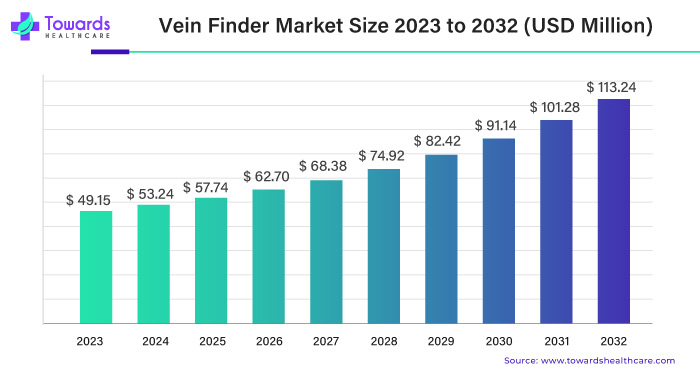
Vein Finder Market Growth and Forecast (2024 – 2032)
The global vein finder market is projected to expand from USD 49.15 million in 2023 to over USD 113.24 million by 2032, with a compound annual growth rate (CAGR) of 8.7% from 2024 to 2032.

Download statistics of this report @ https://www.towardshealthcare.com/download-statistics/5126
Report Highlights:
- Near-infrared technology led the vein finder market with a 57% share in 2023.
- Tabletop models were the most popular type of vein finder, capturing 55% of the market share in 2023.
- Hospitals and clinics accounted for the largest share of the market, with 62% in 2023.
- The integration of advanced technology is having a significant impact on the vein finder market.
As the global population ages, the demand for vein finders is expected to rise. The World Health Organization predicts that by 2050, the number of people aged 60 and older will double to 2.1 billion, and those 80 and older will triple to 426 million. This growing aging population will face more health challenges, including difficulty locating veins, driving the need for improved vein finding technology.
Vein finders are devices used by healthcare professionals to locate veins in patients’ bodies. They use various technologies, such as near-infrared light, to make veins visible, which is especially helpful for patients with challenging vein visibility, like children, elderly people, or individuals with darker skin tones.
These devices are crucial in procedures like drawing blood, inserting IV lines, and administering medications. They help reduce patient discomfort, minimize complications like bruising or multiple needle sticks, and improve the overall efficiency of medical procedures.
The rise in unsafe injection practices, which contribute to infections like Hepatitis B, Hepatitis C, and HIV, is also driving the adoption of vein finders. The World Health Organization reports that approximately 1.7 million people contract Hepatitis B, 315,000 get Hepatitis C, and over 33,800 acquire HIV due to unsafe injections. Vein finders can help reduce these infections and ease the burden on hospitals and patients.
Vein finders are used in various medical settings, including hospitals, clinics, emergency rooms, and even at-home healthcare. They are particularly valuable when vein visibility is poor or when medical staff need to work quickly and accurately.
The increasing popularity of mobile health is expected to further boost the use of vein finders in hospitals and clinics. In 2020, over 350,000 health apps were available for download, and newer apps with advanced technology are now capable of scanning patients’ skin to locate veins.
A research study by the National Institutes of Health, involving 242 participants, assessed the effectiveness of a newly developed vein finder in visualizing and mapping veins on the arm and dorsal hand. The study considered factors like age, skin tone, gender, and arm circumference in its evaluation.
The vein finder market is set for steady growth due to the increasing demand for minimally invasive procedures, more medical procedures requiring venous access, and technological advancements leading to more portable and user-friendly devices. Additionally, the aging population, which often faces challenges in vein access, is driving the demand for these devices.
As healthcare providers continue to recognize the benefits of accurate vein visualization for improving patient care and procedural efficiency, the vein finder market is expected to experience sustained growth.
Recent Developments:
In 2022, Light-emitting diodes (LEDs) became a popular, cost-effective option in the vein finder market. Compared to other devices, LED vein finders were more affordable while also being lightweight and portable. Their versatility was further enhanced by the availability of different colors, making them suitable for various skin tones and ensuring better vein visibility across diverse patient groups. LED vein finders were particularly useful in pediatric care, where their gentle, non-invasive nature and easy-to-use design made them ideal for young patients, allowing for smoother medical procedures.
In February 2021, AccuVein Inc. announced that the Infusion Nurses Society (INS) recommended the use of Near-Infrared (NIR) vein visualization technology during venipuncture procedures. This technology helps healthcare professionals assess veins on the skin’s surface, making it easier to choose the right vein for procedures like blood draws or IV insertions.
Key Companies in the Vein Finder Market:
- AccuVein Inc.
- Christie Medical Holdings, Inc.
- Veincas Ireland Ltd.
- Novarix Ltd.
- TradeMed.com
- Medline Industries, LP
- B. Braun Medical Inc.
- VINO Optics
- TransLite LLC
- Venoscope
Our Table of Content (TOC) covers key healthcare market segments, materials, technologies and trends—helping you navigate market shifts and make informed decisions: https://www.towardshealthcare.com/table-of-content/vein-finder-market-sizing
Access exclusive insight now @ https://www.towardshealthcare.com/price/5126
We’ve prepared a service to support you. Please feel free to contact us at sales@towardshealthcare.com
Web: https://www.towardshealthcare.com
Visit Dental Specifics: https://www.towardsdental.com
Get the latest insights on industry segmentation with our Annual Membership: Get a Subscription
For Latest Update Follow Us: https://www.linkedin.com/company/towards-healthcare




